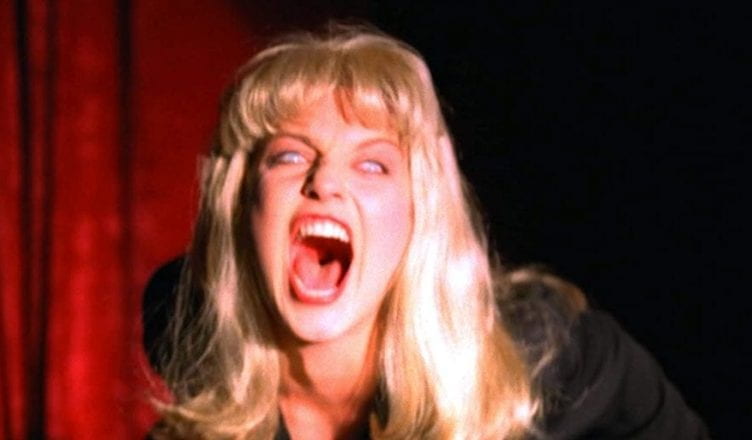Film Deets:
Director: David Lynch
Screenplay: Mark Frost & David Lynch
Actresses: Sheryl Lee, Grace Zabriskie
Category: Child Abuse in Twin Peaks
Themes: Abuse, Recovered Memory, Family Trauma
Why do these screams matter?
With its surrealistic storytelling style and quirky characters, Twin Peaks became an instant cult classic when it initially aired on the ABC network. Centering the brutal murder of the town’s Prom Queen, Laura Palmer (Sheryl Lee), the series garnered almost immediate critical and popular praise for its deconstruction of small-town American life and the horrors that exist behind suburban facades.
The audience’s first encounter with Sarah Palmer (Grace Zabriskie), Laura’s mother, finds her napping on the couch only to awaken screaming.
At first, it appears as though Sarah is screaming because she is having a premonition that something horrible is about to occur, a premonition that proves to be correct when the body of her daughter Laura is discovered. With echoes of maternal grief, this scream, at first, appears to be driven by shock and repulsion. Sarah is quite literally awakening to the reality that the safety of suburbia is an illusion and that even in the most seemingly tranquil of communities, a seedy underbelly of violence lurks.
But this moment gets reframed a few episodes later when Laura’s best friend Donna (Lara Flynn Boyle) visits Sarah. As the two speak, Sarah first imagines Laura’s face superimposed on Donna, before the vision morphs to show the demonic spirit, BOB (Frank Silva), lurking next to Laura’s bed.
The future revelation that Laura was sexually abused by Leland (Ray Wise), Sarah’s husband and Laura’s father, radically upends our understanding of Sarah as a character. This is not just a bereft mother attempting to navigate the violent death of her daughter. Rather, this is a woman who is also grappling with a pronounced sense of guilt. Both of Sarah’s screams take place in the family home and reflect her unconscious understanding that the danger that found Laura outside of the home was also very much present within it. Sarah is slowly beginning to acknowledge the truth about her daughter’s abuse and the part that she played, through her silence, in perpetuating it. The image of Laura’s face coupled with BOB at Laura’s bedside indicates that, at least on some level, Sarah was aware of the abuse.
And this framing of Sarah as a silent accomplice to her husband’s depravity is not without merit. In her article “Mothers Who Fail to Protect Their Children from Sexual Abuse: Addressing the Problem of Denial,” which first appeared in the Yale Law & Policy Review, Christine Adams writes, “Denial is a psychologically incapacitating state that some mothers experience when faced with the possibility that their children are being sexually abused by their partners. Denial can hinder a mother’s capacity to acknowledge, or even consciously know, that such abuse is occurring, thereby preventing her from intervening to protect her child or children. Even in the face of clear evidence that her partner is abusing her child, a mother who is in denial may simply stand by and allow the abuse to continue-often for a period of years.” Sarah’s scream as she finally connects Laura to the lurking BOB by her bed is a tacit admission that her denial of what was occurring in the home failed Laura at every turn.
Our second scream comes from Laura or, at least, her facsimile, and highlights the depths of pain that have resulted from Leland’s abuse and Sarah’s silence. In this scene, Cooper (Kyle MacLachlan) is in the Black Lodge, the series’ shadow location, and is told by its Leland doppelgänger to “find Laura.” When he encounters her doppelgänger, she cryptically says, “meanwhile,” before launching an ear-splitting scream that drives Cooper from the room.
There is little doubt that doppelgänger Laura is furious and that her screams are emanating from a place of profound rage. As a double, her function is to inhabit and express agency and emotion not available to her real-world counterpart. As we will learn in Fire Walk with Me, the franchise’s prequel film, Laura’s sexual abuse has been going on for years. Laura never tells anyone of what she is experiencing, opting instead to detail the horrors she endures in a secret diary. But in the Black Lodge, a place the Twin Peaks wiki describes as “a place of pure evil through which all souls passed on the way to perfection,” evil acts, of which sexual abuse would certainly qualify, are exposed. There is no secrecy involved which eradicates the shame real-world Laura experiences. Emboldened, doppelgänger Laura charges toward Cooper as she unleashes a set of wailing screams indicating she is running full throttle toward acknowledging what Laura has endured. And while it isn’t quite the same thing as Laura reclaiming and asserting her body agency, it is a start and sets the stage for the prequel film.
Adams, Christine. “Mothers Who Fail to Protect Their Children from Sexual Abuse: Addressing the Problem of Denial.” Yale Law & Policy Review, Vol. 12, 1994, p. 519.
“Black Lodge.” Twin Peaks Wiki, twinpeaks.fandom.com/wiki/Black_Lodge.
“Part 2.” Twin Peaks: Season Three, written by Mark Frost and David Lynch, directed by David Lynch, Lynch/Frost Productions, 2017.
“Pilot.” Twin Peaks: Season One, written by Mark Frost and David Lynch, directed by David Lynch, Lynch/Frost Productions, 1990.





